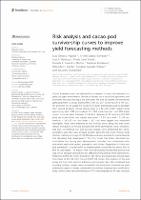Risk analysis and cacao pod survivorship curves to improve yield forecasting methods

View/
Date
22-03-2024Author
Orozco-Aguilar, Luis
López Sampson, Arlene
Barboza, Luis A.
Borda, María José
Leandro Muñoz, Mariela E
Bordeaux, Melanie
Cerda, Rolando H
Ayestas Villega, Eusebio
Somarriba, Eduardo
Sustainable development goals
ODS 12 - Producción y consumo responsables
Type
Artículo
Metadata
Show full item recordAbstract
Cocoa attainable yields are affected by a complex of pests and diseases in a particular agro-environment. Estimation of yield loss is critical for agronomic and economic decision-making at the farm level. For over 15 months, we monitored 1100 pods from six cocoa clones (PMCT-58, CC-137, CATIE-R1 CATIE-R4, ICS-95, and CCN-51) to assess the incidence of pests and diseases and to elucidate their survival behavior. Cocoa clones grow in a 12-year timber-based cocoa agroforestry plot (1330 cocoa plants ha-1, 100 shade trees ha-1, and 65% shade cover), in La Montaña, Turrialba, Costa Rica. Between 6-12 trees and 120-140 pods per clone of four size classes (very small – 2.5-7 cm, small – 7.1-14 cm, medium – 14.1-21 cm, and large – ≥21 cm) were tagged and measured fortnightly. Pods were selected at two vertical strata along the tree trunk (below and above 1.5 m) and grouped into three generations (rainy, transition, and dry). Competitive risk and survival analysis were performed per clone, generation, pod size class, and pod position along the tree trunk. Overall, pods reached maturity at the age of 155-165 days and were exposed to several hazards that disrupted their development. The Cox model that better described the cumulative risk during pod development included two covariables with substantial explicative power, generation, and clones. Regardless of clone and pod generation, a combination of diseases/pests accounted for about 45% to 65% of yield losses. The Kaplan-Meier survival analysis showed that pod survival was similar between generations but differed among clones within generations. Pods from CATIE-R1, CATIE-R4 and CC-137 clones showed greater survival rates than those of ICS-95, CCN-51 and PMCT-58 clones. The position of the pod along the tree trunk did not influence pod survival rates. We combined pod counting and pod survival rates calculated in this study and contrasted our yield estimations against a widely used prediction method proposed by a certification body. Overall, yield estimated using the UTZ method applied to 90-day-old pods of CATIE-R1 clone consistently overestimated yield predictions in the range of 27-45%. We proposed the combination of pod counting and pod index with a set of clone-specific discount factors; the survival rates, to reliably forecast on-farm cacao yields over time.
Keywords
Supervivencia||survival||sobrevivência||survie, Peligros||hazards||undefined||danger, Plantas de sombra||shade plants||planta de sombra||plante d'ombrage, Theobroma cacao||Theobroma cacao||Theobroma cacao||Theobroma cacao, Vainas||pods||vagem||gousse, Rendimiento||yields||rendimento||rendement, Shaded cocoa, Pod counting, Pod index, Attainable yields,
Delegation
Sede Central
Publisher
Frontiers
Is part of
Agronomy
Status
openAccess
xmlui.dri2xhtml.METS-1.0.item-uri-link
https://doi.org/10.3389/fagro.2024.1290035

